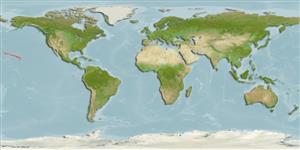>
Eupercaria/misc (Various families in series Eupercaria) >
Scaridae (Parrotfishes) > Sparisomatinae
Etymology: Calotomus: Greek, kalos, kallos = beautiful + Greek, tomos = section, cut (Ref. 45335).
Environment: milieu / climate zone / depth range / distribution range
Ökologie
seewasser riff-verbunden; tiefenbereich 12 - 170 m (Ref. 525). Tropical
Pacific Ocean: Midway and Hawaiian islands.
Size / Gewicht / Alter
Maturity: Lm ? range ? - ? cm
Max length : 33.0 cm TL Männchen/unbestimmt; (Ref. 9710)
Rückenflossenstacheln (insgesamt) : 9; Rückenflossenweichstrahlen (insgesamt) : 10; Afterflossenstacheln: 3; Afterflossenweichstrahlen: 9; Wirbelzahl: 25. When fresh, reddish brown to brown dorsally, reddish to almost white ventrally; irregular fine whitish marks on scales. Head with white speckling; a reddish transverse band on chin, followed by a diffuse white band; reddish iris. Whitish pectoral fins, base reddish brown; 3 narrow irregular brownish red stripes on whitish pelvic fins. Pungent dorsal spines; rounded caudal fin at all sizes. Skin dark around anus, almost black. Lateral line interrupted.
Occurs in areas of coral rock with coral or rubble, from the lower surge zone to at least 10 m (Ref. 9710). Benthopelagic (Ref. 58302). Protogynous (Ref. 55080).
Life cycle and mating behavior
Maturities | Fortpflanzung | Spawnings | Egg(s) | Fecundities | Larven
Pair spawnings involved an initial- and a terminal-phase fish; group spawnings involve several of both. Investigations strongly suggest that the species is gonochoristic.
Bruce, R.W. and J.E. Randall, 1985. A revision of the Indo-West Pacific parrotfish genera Calotomus and Leptoscarus (Scaridae: Sparisomatinae). Indo-Pac. Fish. (5):32 p. (Ref. 525)
IUCN Rote Liste Status (Ref. 130435)
Bedrohung für Menschen
Harmless
Nutzung durch Menschen
Fischereien: kommerziell; Aquarium: Kommerziell
Tools
Zusatzinformationen
Download XML
Internet Quellen
Estimates based on models
Preferred temperature (Ref.
123201): 8.9 - 21.7, mean 13.5 °C (based on 11 cells).
Phylogenetic diversity index (Ref.
82804): PD
50 = 0.5312 [Uniqueness, from 0.5 = low to 2.0 = high].
Bayesian length-weight: a=0.02089 (0.00803 - 0.05439), b=2.98 (2.75 - 3.21), in cm total length, based on LWR estimates for this (Sub)family-body shape (Ref.
93245).
Widerstandsfähigkeit (Ref.
120179): hoch, Verdopplung der Population dauert weniger als 15 Monate. (Preliminary K or Fecundity.).
Fishing Vulnerability (Ref.
59153): Low vulnerability (23 of 100).
Nutrients (Ref.
124155): Calcium = 36.1 [13.3, 97.9] mg/100g; Iron = 0.624 [0.246, 1.542] mg/100g; Protein = 18 [16, 20] %; Omega3 = 0.0728 [, ] g/100g; Selenium = 20.2 [6.3, 62.8] μg/100g; VitaminA = 33 [7, 140] μg/100g; Zinc = 1.82 [0.86, 3.26] mg/100g (wet weight);
